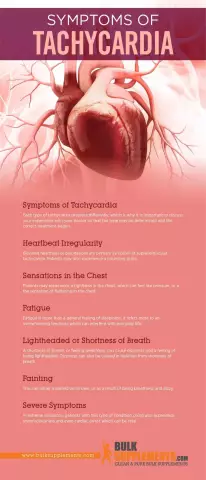- Author Curtis Blomfield [email protected].
- Public 2023-12-16 20:44.
- Last modified 2025-06-01 06:18.
Children have a much higher heart rate than adults. This is due to the high need of the body for oxygen and the rapid flow of metabolism. In addition, babies are constantly on the move. But sometimes the heart rate begins to exceed the norm. And after the examination, sinus tachycardia is diagnosed in a child. What is this pathology and how to treat it?
Characteristics of pathology
Let's look at what sinus tachycardia is in a child. As mentioned above, this is a disease associated with an increase in the frequency of heart contractions. The pulse can significantly exceed the age norm. Such a rhythm is formed from the sinus node, which is an impulse generator that determines the frequency of contractions. A wave of excitement appears in it. It extends to the entire heart muscle and promotes its synchronous functioning.

Sinus tachycardia in a childmay be long-term or transient (situational).
Increased heart rate is usually the body's response to internal and external factors:
- mental tension;
- physical activity;
- emotions;
- prolonged hypoxia;
- pathology of the heart, lungs.
Causes of occurrence
Initially, it should be said that sinus tachycardia in a child of 6 years old and at a younger age is often considered the norm. These children do not require any treatment. These violations are intermittent. Over time, they go away on their own. An increase in heart rate to 100-160 beats per minute, resulting from stress, physical activity, hyperthermia, prolonged exposure to a stuffy room, is not a sign of pathology. But if such a condition is accompanied by additional symptoms (we will talk about it below), then the baby will need the treatment of professionals. And special attention should be paid to the pathology in the event that a violation is found in a perfectly he althy baby, who was in a calm state.

What can lead to the development of such a violation? Doctors say that sinus tachycardia appears, as a rule, as a result of the following reasons:
- heart failure (congenital);
- myocarditis;
- anemia or hypoglycemia;
- CNS damage.
At older age, the sources of the disease in children can be:
- unevenly developing organs leading tomalfunction;
- stress situations;
- diseases of the cardiovascular and nervous systems;
- too high physical activity;
- disruption of the thyroid gland.
Characteristic symptoms
To determine which pulse is considered a symptom of tachycardia, you should familiarize yourself with the age norms. Doctors cite the following indicators:
- babies up to 5 months - 140-160;
- babies 6 months - 130-135;
- crumbs 1 year old - 120-125;
- children aged 2 - 110-115;
- babies at 3-4 years old - 105-110;
- children 5-7 years old - 100-105;
- schoolchildren 8-9 years old - 90-100;
- children 10-12 years old - 80-85;
- teenagers from 12 years old - 70-75.
Pathology is diagnosed if the pulse rate exceeds the indicated age norms by 10-60%. Thus, sinus tachycardia is suspected in a 1-year-old child with rates above 140 beats.

However, the development of pathology is indicated not only by the number of heart contractions. Additional symptoms that characterize the disease are:
- pain in the region of the heart;
- sudden dizziness;
- shortness of breath for no reason;
- weakness;
- darkening in the eyes with sudden movements;
- fainting.
This is how severe sinus tachycardia manifests itself in a child.
Diagnostic Methods
To detect this disease, the doctor prescribes special examinations:
- Electrocardiogram. Sinus tachycardia is quite clearly manifested in children on the ECG. The results show a violation of the frequency and intensity of contractions of the heart. The teeth on the cardiogram, as well as the intervals between them, allow the doctor to quickly make a diagnosis.
- Ultrasound. The study evaluates the functioning of the heart and the condition of the valves.
- A blood test for the amount of thyroid hormones gives an idea of the possible causes of tachycardia.
- MRI reveals pathologies of the heart that provoke diseases.
- Electrocardiogram according to Holter. Such a study makes it possible to fix the functioning of the heart for 1 day. With the help of this examination, the work of the body under various loads is determined.
- Electrophysiological study allows you to study the mechanisms of pathology by the method of distributing an impulse through the heart.

Treatments
Methods of dealing with pathology are rather ambiguous. If the symptoms of tachycardia are absent, and the baby feels well, then he may well do without medication. However, such children are recommended to systematically undergo repeated examinations and visit a cardiologist. If the sinus tachycardia of the heart in a child proceeds with unpleasant symptoms, then drug therapy is mandatory. At the same time, children are recommended to take drugs designed mainly for adults. That is why doctors prescribe them very carefully, choosing the right dosages and regimens.treatment.
Typically, therapy consists of the following drug groups:
- sedative drugs;
- drugs involved in hematopoiesis;
- vitamin complexes;
- cardiac glycosides (if the problem is in the heart).

It is extremely dangerous and contraindicated to experiment with medicines on your own! With such a pathology, medications should be prescribed exclusively by a cardiologist. In case of a disease provoked by stressful situations, decoctions of soothing herbs are prescribed: motherwort, valerian, mint.
Stopping an attack
Parents should be prepared for the fact that at any time the child may suddenly show negative symptoms. If an attack occurs, you must act as follows:
- Be sure to provide air access. Open the collar, bring or take the baby to the window.
- Put a cool towel over your forehead.
- Have the child take a deep breath and hold it for a few seconds. This simple procedure can lower your heart rate.
If these actions were not enough, and the baby's condition does not improve, then immediately call the doctors.
Prevention measures
To avoid the occurrence of a disease such as sinus tachycardia in a child, carefully monitor the he alth of the crumbs.

It is very important to ensure the following prevention:
- Child should rest normally.
- Providing adequate nutrition is essential.
- It is important to protect your baby from stress.
- Get outdoors every day.
- Properly dose physical activity, especially if the child plays sports or is a lover of outdoor games.
- Parents need to eliminate all bad habits. After all, they have a very negative impact on the he alth of babies.
Sinus tachycardia is not considered a serious illness. However, it is very important to control the condition of the child. And if the doctor has prescribed medications, then such therapy must be fully observed.






